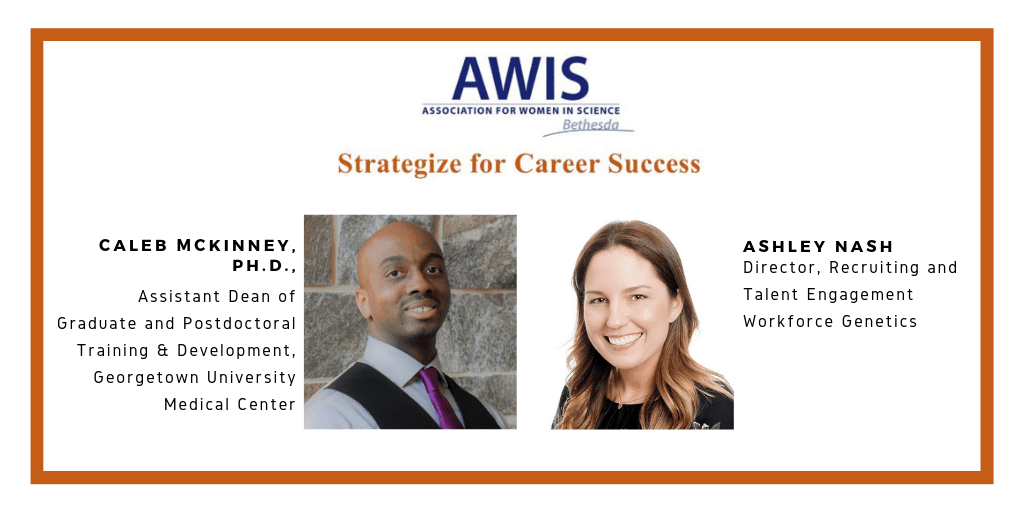
The Right Strategies for Scientists to Achieve Career Success in Industry
June 11, 2019
When it comes to navigating career growth in science, many feel as though they are entering uncharted waters in a ship with no sail. For women in science, there can be even more challenges. The Association for Women in Science (AWIS) sought out to help calm the seas at the ‘Strategies for Career Success’ panel discussion with expert advice from Caleb McKinney, PhD, Assistant Dean of Graduate and Postdoctoral Training & Development at Georgetown University and Ashley Nash, Director of Recruiting and Talent Engagement at Workforce Genetics.

With unemployment at 3.6%, thirteen STEM jobs for every one job seeker, and 2,000 open biotech jobs in the Capital Region, you would think that as a PhD you would be chasing away job prospects with a bat. Sadly, that’s not the case for many who face quite the opposite experience. McKinney referred to this as ‘The STEM Paradox.’ “We’re in the middle of a bustling market of stem job opportunities that PhD’s can’t seem to penetrate.”
McKinney is passionate about this topic because for him it really comes down to helping students find “the nexus of the trifecta.” That means really finding out what lies in the center between, “what I enjoy, what I’m good at and what people will pay me to do.” He encourages his students to really think about assessing what they like, and what they are good at and merging them together.
Wanna break past that paradox and get the job you’ve always wanted? These are some of the top pieces of advice that can help you do just that.
How do I position myself to be attractive for an industry employer?
This is a question that faces many of the brilliant PhD’s and other scientists working in basic research who are looking to spread beyond the walls of NIH or their academic institution. McKinney recommends asking yourself, “How do I show I’m capable of doing that work?”, and then building a bridge between your past experience and the requirements of the job you want. “That means having a clear idea on what that work is so that you can deliberately align your skill set to it and find experiences that aling with what you want to do so that employers can see that you can quickly get up to speed with what they need.”
Another important step that is often overlooked is learning the language of the industry you are interested in. “Build out the literacy of that particular sector, suggests McKinney. “You need to know the industry trends, literature and language so you can talk the talk. That’s often what gets you in the door and signals to the hiring manager or recruiter that you know what you’re talking about and have the potential to be a good candidate.” It’s also important to make sure that the right language is used in your resume as well.
Is it appropriate to water down your resume to mold it to the job you want and make it applicable?
Your resume is the first thing that a recruiter or hiring manager may see so it’s important to get it right. It’s also a tough task for many scientists who are trying to summarize their highly technical expertise, publications, patents and accomplishments into a few pages that will stand out to someone outside of academia.
There are a few important tips that will help make this easier and help your resume to stand out. First, make sure you are adding the right language and experiences into your resume as they described in the job description. “Think of it as telling the appropriate story for the job you are applying to,” shared Nash. “Also, instead of long paragraphs, frame your resume to the bullet points from the job posting and write about what you achieved, not just what you did.”

This isn’t ‘watering down’ your resume. As McKinney conveyed, “It’s re framing it to build the bridge.” This means that if a job is looking for project management experience as a requirement, it’s all about how you re-frame your experience to highlight similar project management experiences. “It doesn’t mean you have to have been a project manager. Most of you conducted a project for a grant you received. So, without going into the weeds about all the scientific details focus your resume on how you managed the grant and the research to achieve the goals.”
McKinney also suggested that you should have a folder of different resume formats. One resume with publications for R&D jobs, and another for other jobs that may not care about publications as much. One great tip for managing your publications is to just add the link to NCBI on PubMed where all of your publications are.
How do you best use and leverage your network?
Everyone has a network, but not everyone knows how to use it. Nash suggested that it all begins with first knowing exactly what you are looking for and what your ‘ask’ is. The more clear you are with what it is you are asking your network for the easier it will be for them to help and the more likely you will get a response.
For example; instead of saying “Do you know anyone who is hiring?” you might say, “I’m looking to leverage my years of scientific project management experience to advance my career. Who do you know in project management who would be open to an informal, informational interview so I can expand my knowledge and network in the field?” The second is much more specific and professional.
McKinney also shared how contributing your knowledge as content on LinkedIn can help. “Don’t just go to your network with open hands. That’s the quickest way to get people to start ignoring you,” he shared. “Contribute content, write blogs and get your ideas out there on LinkedIn to show your network who you are.” He shared a story about one student who drew cartoons of oncologic projects she was doing. These cartoons showed that she can translate complex scientific principles to ways that Doctors, or broad audiences, can understand. Those cartoons got her a job as a Medical Science Liaison.
Is LinkedIn Premium worth it for job seekers?
McKinney suggests, “Just connect with the person you want to and use the 300 characters in the personal message to remind them where you met them.” In fact, Georgetown’s Career Catalyst blog has various templates you can use in “The Power of Informational Interviews” article. He also recommends that you leverage your institution’s Alumni who are out there in industries around the world. A simple, “Fellow Hoya here; I’d love to connect,” will go a long way and people love that.
Is it a good idea to reach out to a hiring manager or CEO?
This is something that might make you feel uncomfortable doing, but according to Nash “It helps you stand out and get out of that ‘resume black hole’ that many applicants get stuck in.” She does recommend that you do your homework first so you’re knowledgeable on the company and use that to show you’re invested in the company. Here are two good LinkedIn invitation messages you can use;
“I heard about what you’re doing with A,B,C and would really like to get involved and add value to ‘Company’. I’ve learned a lot about X,Y,Z through my experience and I’m passionate about this field.”
“I recently applied to a job at your company and wanted to introduce myself. I’m really interested in this area of what your doing and think that I can add value with my x# years of experience.”
What’s the best way to prepare an elevator pitch?
If you do get a response from the CEO or hiring manager, you’ll often have one shot at a first impression. This can be quite intimidating but there are some great tips for making this easier.
McKinney says that this process really begins with a branding exercise where your aim is to get your audience to remember the key thing you want them to remember. So first, you need to understand the audience and what they need. A good starting point is to take 10 or so of the skills in a job description and write 3-4 sentences for each blurb to skill. “Reflect back on your past experiences and show how those experiences have shown and built up that skill, and what you have accomplished with that skill,” he recommends. “That’s how you practice reflecting on past experiences for your elevator pitch.”
Another important piece is to make sure you have a pitch that the audience will want to hear about, that isn’t too long. Using the exercise above you can craft a pitch for different audiences and see how your pitch changes. “It’s an important exercise to help you explain your skills and synthesize them for the job and different audiences.”
Nash recommends getting your elevator pitch down to 20 -30 seconds or you’ll start to lose your audience. “It goes back to really knowing your ‘Nexis of the trifecta’ and telling your own story in a concise statement of who you are in relation to what they are looking for.” Nash also pointed out that women often have a hard time with this and think that talking about themselves is bragging, but it’s not. She recommends practicing your elevator pitch with someone else including friends, co-workers, mentors and record yourself so you can hear how you sound.
Stay tuned for more tips and advice from McKinney and Nash as we will explore this topic further to give you the tools to advance your career and achieve your career goals.
- About the Author
- Latest Posts
Over the past 11 years, Chris has grown BioBuzz into a respected brand that is recognized for its community building, networking events and news stories about the local biotech industry. In addition, he runs a Recruiting and Marketing Agency that helps companies attract top talent through a blended model that combines employer branding and marketing services together with a high powered recruiting solution.





